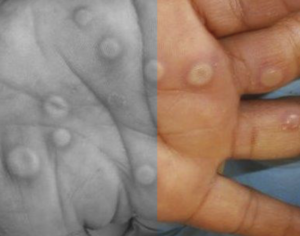Levels of monkeypox viral load in different body sites supports highest risk from body contact
3 October 2022. Related: mpox.
Simon Collins, HIV i-Base
 The largest prospective study on the viral dynamics of monkeypox in multiple tissue types and samples provides an important dataset to help understand the relative risks of transmission.
The largest prospective study on the viral dynamics of monkeypox in multiple tissue types and samples provides an important dataset to help understand the relative risks of transmission.
Skin and anal swabs were more likely to be positive and at higher levels than other samples, such as in semen where only half were positive and at much lower levels.
The study included 356 samples from skin, anus, throat, blood, urine, and semen in 50 men with monkeypox (MPX) attending the Pitié-Salpêtrière Hospital in Paris. It reported whether samples at diagnosis (and after 14 days in 24 men) were positive, using PCR cycle thresholds [Ct] to indicate viral load (lower Ct = higher viral load).
Participants were recruited during May and June 2022. Median age was 34 (IQR: 29 to 40) and 44% (22/50) men were living with HIV, all with undetectable viral load on ART, except one new diagnosis. Skin samples were taken from the same lesion at both timepoints and anal and throat swabs were not taken from lesions, even if present. Baseline samples were taken a median of 5 days (IQR: 3 to 6) from symptoms.
The results showed highest levels of detection and at significantly higher viral load in skin and anal samples compared to throat, blood and semen. Viral load in anal swabs was significantly high in those with anal lesions (Ct 19·6 vs 25·3, p=0·0073). Similarly, viral load was also higher in semen samples of patients with genital lesions (Ct 26·3 vs 30·2, p=0·022).
At Day 14, only 6/24 participants with paired samples had Ct values <35.0. This included 4 skin samples, 2 anal samples and 2 semen samples.
Importantly, detection significantly declined in all samples by Day 14, see Table 1.
Table 1: MPV in different sites at Day 0 and 14
| Detection at D 0
% (n) |
Viral load at D0
(Ct) |
Detection at D 14
% (n) |
|
| skin | 88% (44/50) | Ct 19·8 | 22% (4/18) |
| anus | 71% (30/42) | Ct 20·9 | 9% (2/22) |
| throat | 77% (36/47) | Ct 27·2 | 0 (0/21) |
| blood | 29% (13/45) | Ct 32·8 | 5% (1/21) |
| urine | 22% (9/41) | Ct 31·1 | 0 (0/14) |
| semen | 54% (13/24) | Ct 27·8 | 9% (2/11) |
Key: D = day, Ct = cycle of transmission.
These results led the researchers to conclude that high viral load in skin and mucosa, including genital and anal sites, suggest that transmission most likely occurs through direct body contact rather than through the respiratory route or contact with body fluids, and that transmission is also possible through kissing, oral sex and breathing.
comment
This is the largest prospective study to report on viral dynamics of MPX and the results are helpful for suggesting a scale of relative risk based on type of exposure. One caution is that the threshold levels for infection are not known and these might vary for different types of exposure.
It would be helpful if future studies could continue beyond 14 days to understand whether risk continues after skin lesions have healed, notably in semen.
Other studies have reported positive DNA results in blood and semen, albeit at low rates. [2, 3]
However, even though isolation of MPX DNA from semen has been reported it is unclear whether this is a risk of transmission. [4, 5]
References
- Palich R et al. Viral loads in clinical samples of men with monkeypox virus infection: a French case series. Lancet Infectious Diseases, DOI: 10.1016/S1473-3099(22)00586-2. (29 September 2022).
www.thelancet.com/journals/laninf/article/PIIS1473-3099(22)00586-2/fulltext - Thornhill JP et al. Monkeypox Virus Infection in humans across 16 countries—April-June 2022. N Engl J Med. 2022; 387: 679-691
- Tarín-Vicente EJ et al. Clinical presentation and virological assessment of confirmed human monkeypox virus cases in Spain: a prospective observational cohort study. Lancet. 2022; 400: 661-669.
- Lapa D et al. Monkeypox virus isolation from a semen sample collected in the early phase of infection in a patient with prolonged seminal viral shedding. Lancet Infect Dis. 2022; 22: 1267-1269.
- Reda A et al. Viral replication and infectivity of monkeypox through semen. Correspondence. Lancet Infect Dis. DOI: 10.1016/S1473-3099(22)00611-9. 29 September 2022.

